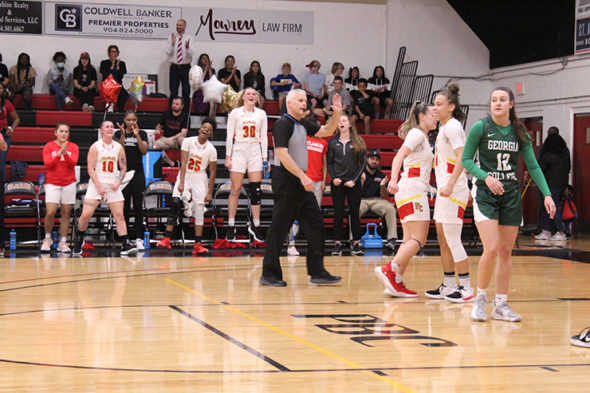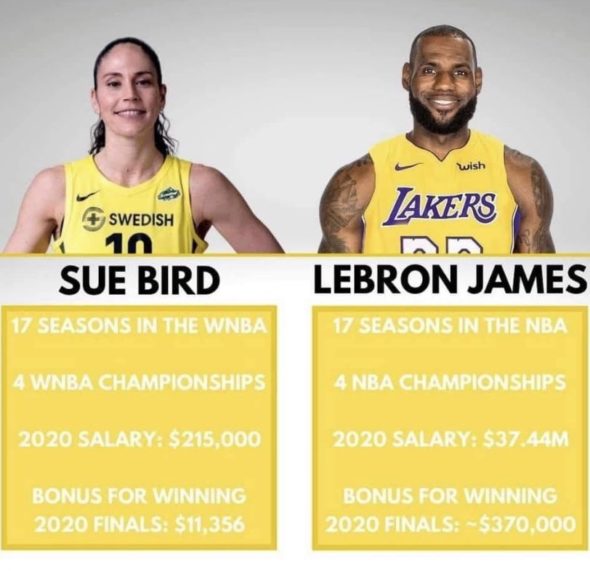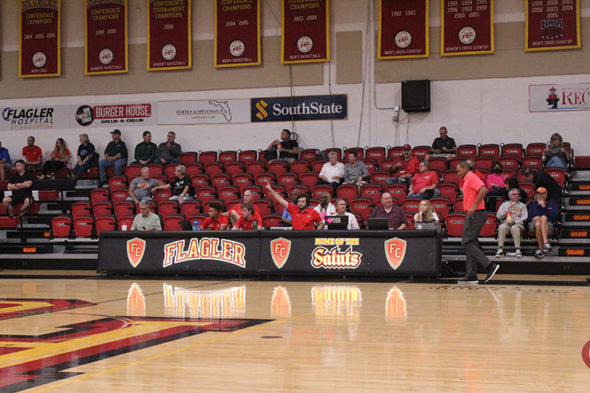By Gabby Alfveby
Rebeka Benge, a Flagler College sophomore and shooting guard, wears jersey #4 for the Saints’ women’s basketball team. She feels strongly about the inequalities that she faces as a female athlete.
“Big sponsorships look for men’s basketball instead of women,” said Benge. “And people just think they’re more exciting because they’re able to dunk but you know some girls are on the come up and they’re starting to dunk. So, I think that will help us out a little bit.”
In a recent Women’s Sports Foundation equity report it was found that 87% of schools offered disproportionately higher rates of athletic opportunities to male athletes. The National Collegiate Athletic Association (NCAA) demonstrated this during March Madness in 2020 when videos surfaced of the unequal training facilities and more.
U.S. House members wrote a letter addressing NCAA president, Mark Emmert attacking him for failing to carry out policies to establish gender equity and accused him of violating Title IX.
The Title lX Coordinater at Flagler College, Jessica Kobryn, has held the position for over four years.
“Title lX provides equitable access, and that’s for all genders,” said Kobryn. “So for athletes specifically, male and female. It basically just makes sure that athletic programs are providing an equitable experience to all of their athletes.”
According to Kobryn, people have swept sports in Title lX under the carpet.
“It’s not explicitly talked about in the new regulations really, [but] Title lX has kind of taken a shift towards sexual violence and harassment and stalking and some people forget about the athletic side because it’s not focused on anymore as much as it used to be,” Kobryn said.
The House members revealed that starting for eight years the men’s budget for Divison I basketball was more than twice the size of the women’s basketball budget from 2013-2021.
Gender inequality in women’s basketball doesn’t just happen on a national level but also at Flagler College.
At Flagler, female players on the basketball team say the women’s basketball program at Flagler College faces gender inequalities through fan attendance, equipment differences and travel plans. Men’s basketball gets more attention than women’s basketball at every level.

Taylor Gardner, a freshman point guard and #5, uses the attention difference as motivation.
“If anything it’s kind of a fuel. I know we had big expectations for this year which didn’t turn out great, but it was our locker room being so much worse and them receiving so much more attention,” she said. “It’s like okay well if we win a championship or we make it far then hopefully we’ll receive some attention.”
The women’s basketball team has a significantly smaller locker room than the men’s team.
“It’s definitely noticeable here just because it’s a smaller school,” Benge said, pointing to differences in the size of locker rooms. “(The boys) have a whole room for massage chairs and our locker room is basically a closet where you have no space.”
Jaziana Mathis is a guard and wears #15 for the Saints. She is a veteran player and is negatively impacted by some of these privileges that the men receive.
“It’s annoying. It makes me pretty pissed off honestly,” Mathis said, as she expressed her frustration of unequal treatment. “I have a different perspective, too, cause this is my sixth year, so I was here when the boys’ team was crap … and [the men’s team] got that locker room before they started winning.”
Mathis also alluded to gaming systems in the men’s locker room and said that it agitates her when she sees this but is still touching butts while changing.
Fan attendance is significantly low at the women’s games compared to the men’s games and has a heavy influence on team performance.
“I think it definitely boosts our energy when we have a bigger crowd, and we could feel it,” said Mathis. “When the gym is empty we could definitely feel it and feel how dead it is. So it’s a huge impact.”
Flagler College hosts ‘Saints Madness’ to kick off the basketball seasons.
This year the women’s players said they were unsatisfied with how they were treated compared to their male counterparts. They weren’t photographed and were hidden behind their male counterparts. They announced the men’s team with enthusiasm but casually announced the women’s team.
“We were standing like right here and then the boys got called out and they literally just stood right in front of us. And we were just in the back. And then that same night, there was a photographer there and she only took pictures of the guys. She didn’t take any pictures of us. At all. It’s like we weren’t even there,” Gardner said.

Matt Green, the Senior Associate Director of Athletics spoke on the initiatives Flagler College takes to try and prevent inequality between mens and womens sports.
“Flagler College Athletics has mechanisms in place to mitigate inequality,” said Green. “Financially, counterpart men’s and women’s programs have identical operating budgets … Differences exist between baseball and softball due to disproportionate roster sizes unique to each sport. Differences exist between men’s and women’s lacrosse due to equipment disparities.”
Issues of inequality also occur on a professional level. The NCAA hired a law firm to investigate these gender disparities and they concluded that the NCAA does prioritize men’s basketball, contribute to inequality, and significantly undervalue women’s basketball. This report was followed by Sedona Prince, an Oregon women’s basketball player, who exposed unequal treatment between men and women’s basketball teams during the 2020 March Madness tournament.
Price posted a TikTok which showed the inequalities between weight rooms and other aspects during last year’s March Madness tournament. Women’s sports in general showcase to what extent gender inequality exists.
There is a misconception when it comes to combating gender inequality in sports. Sue Bird, a Uconn alum and Veteran point guard for the WNBA’s Seattle Storm, advocates for women basketball. She said that her and other players in the league don’t mean they want to be paid the same as NBA players when they talk about equity. The players want to have the same media coverage as the NBA so they could eventually make a larger salary after the league is able to grow. Bird has to cope with receiving hate comments when the two leagues are compared.
A meme that was released in 2020 compared assets such as salaries between Bird and NBA player Lebron James. Bird said she was trolled after it was released and was told “maybe if you had viewership you would have that money.”

These accounts of inequalities affect the women’s team mentally and emotionally.
“It makes me feel unappreciated and lesser than I guess,” Gardener said. “Me and my team kinda feel like almost not enough compared to them. You know we are very talented college athletes, and we are not treated nearly the same as they are.”
Flagler College’s Women’s Basketball Head Coach Mo Smith denied all inequalities that exist and thinks his team needs to win more to receive equal recognition.
“I do not find that there is any ‘inequality gap’ between the Men’s and Women’s Basketball programs,” said Smith. “In fact, the per-athlete expenditure is larger for the women in comparison to the men. In order to receive more recognition, teams need to win more, and that’s our goal to as a team moving forward to win more games and garner that recognition.”
Sofia Grimault is a fan and student at Flagler College. She spoke on why she thinks men and women’s basketball receive a difference in recognition.
“I think that just because they have that preconceived notion that guys teams are better and everything and that also they sort of don’t give that much care for the girls. It’s more individualized and team effort versus just like ‘oh I need to win’ so the school will care about me,” she said.
There are a variety of solutions to these inequalities that people such as fans, parents, coaches, students, and the school could do to help.
Women’s sports aren’t appreciated worldwide.
“I would say just putting more emphasis on appreciating women’s sports. I feel like there’s a lack of appreciation and it kinda spreads to like fans and just like decisions that are made in administration and stuff like that so I feel like just more care towards women’s sports,” Mathis said.

A higher fan attendance is important to the women’s basketball team.
“Our games are right before the boy’s games,” Gardner said. “The fans could come a little bit earlier instead of showing up on time for the boy’s game, even if it’s just half the game.”
Female basketball players say that the inequality between the men and women’s basketball teams at Flagler College is apparent but despite this the women’s team is still able to confide within each other for support.
Gardner shares that her and her teammates all go through the same struggles: insecurity, self-image issues, mental health issues, and more.
“When you’re on a team with all females,” said Gardner, “it makes you feel like a place where you belong. A place where you’re accepted, and you could be different and everybody just loves you for who you are.”



Be the first to comment on "Facing Inequality On and Off the Court: The Disparities Between Male and Female Athletes"